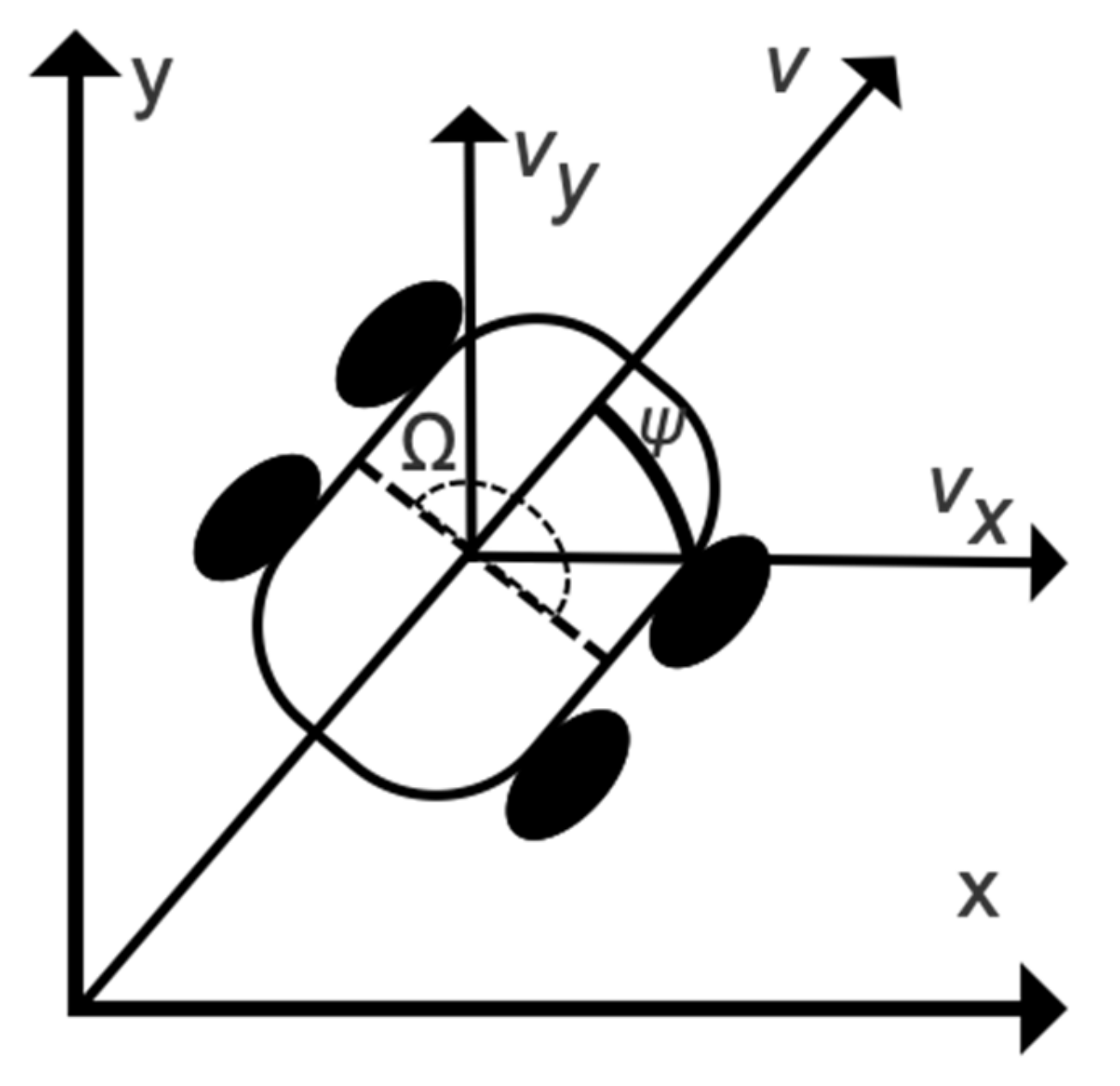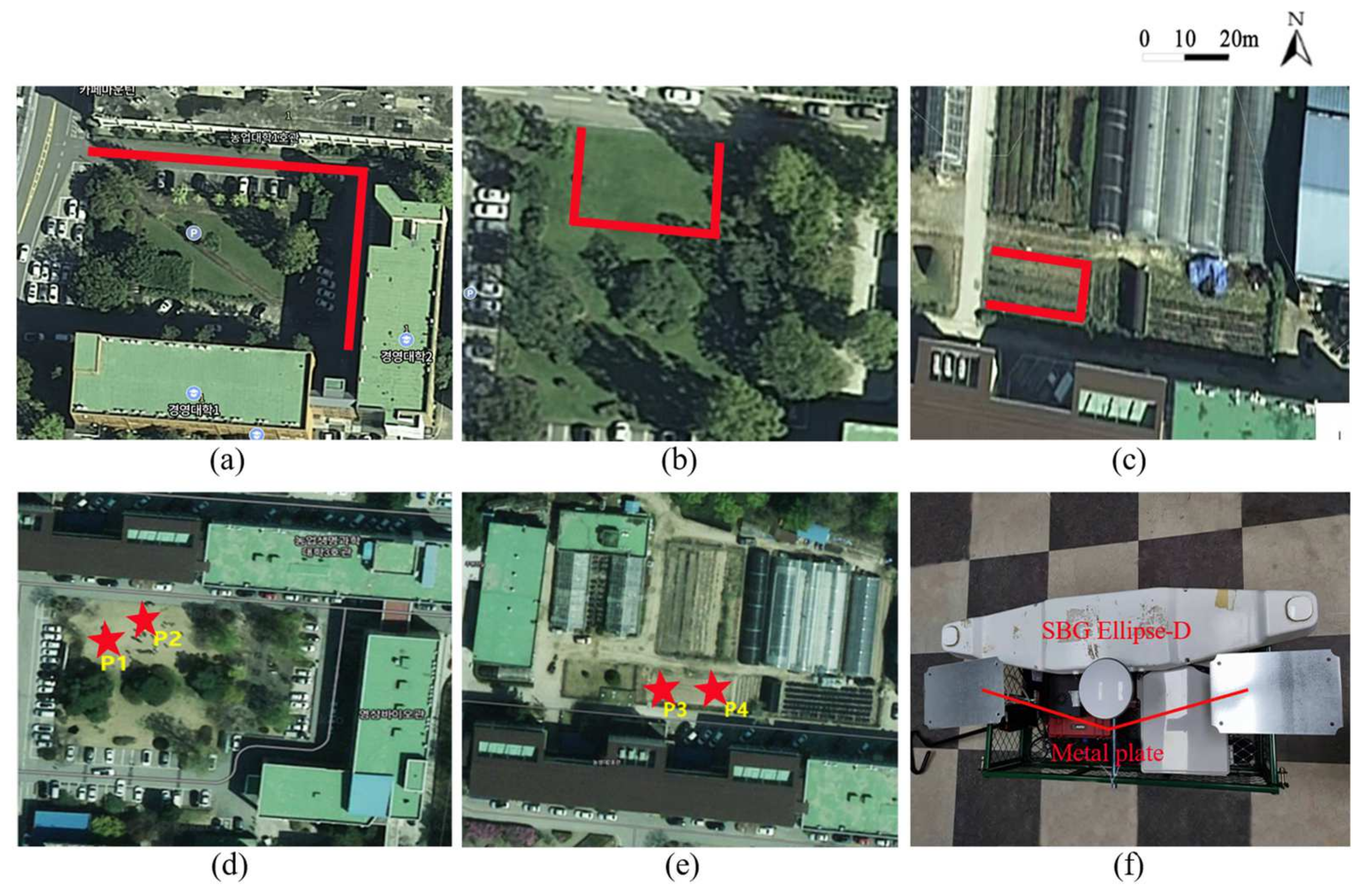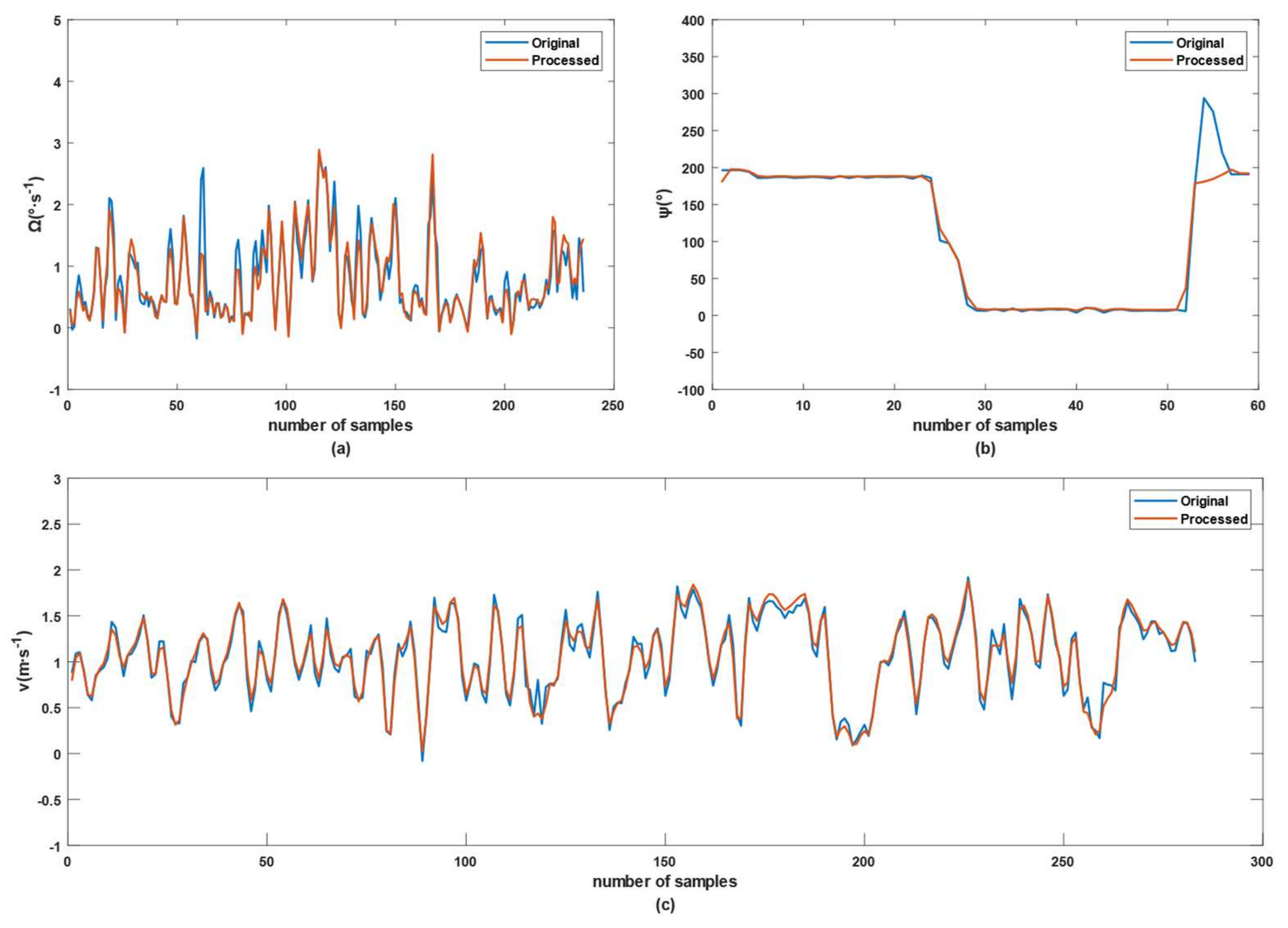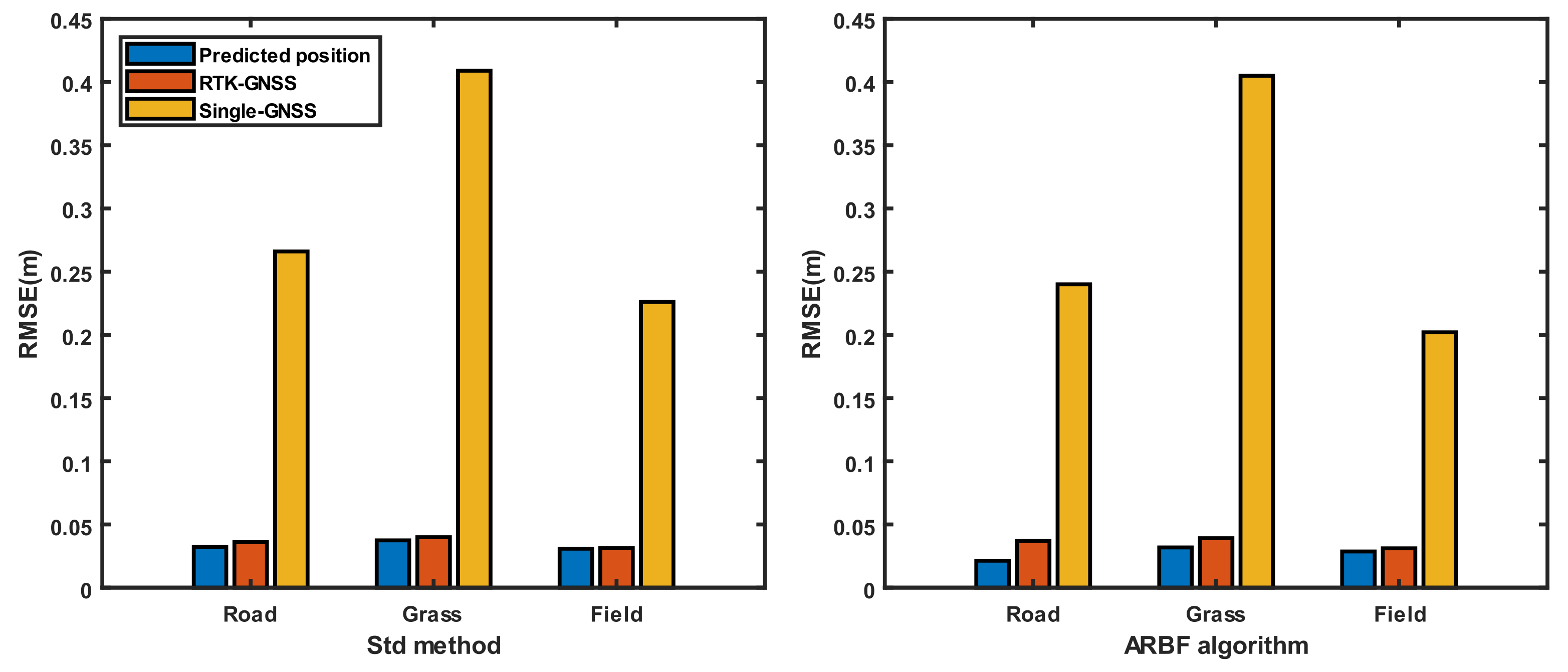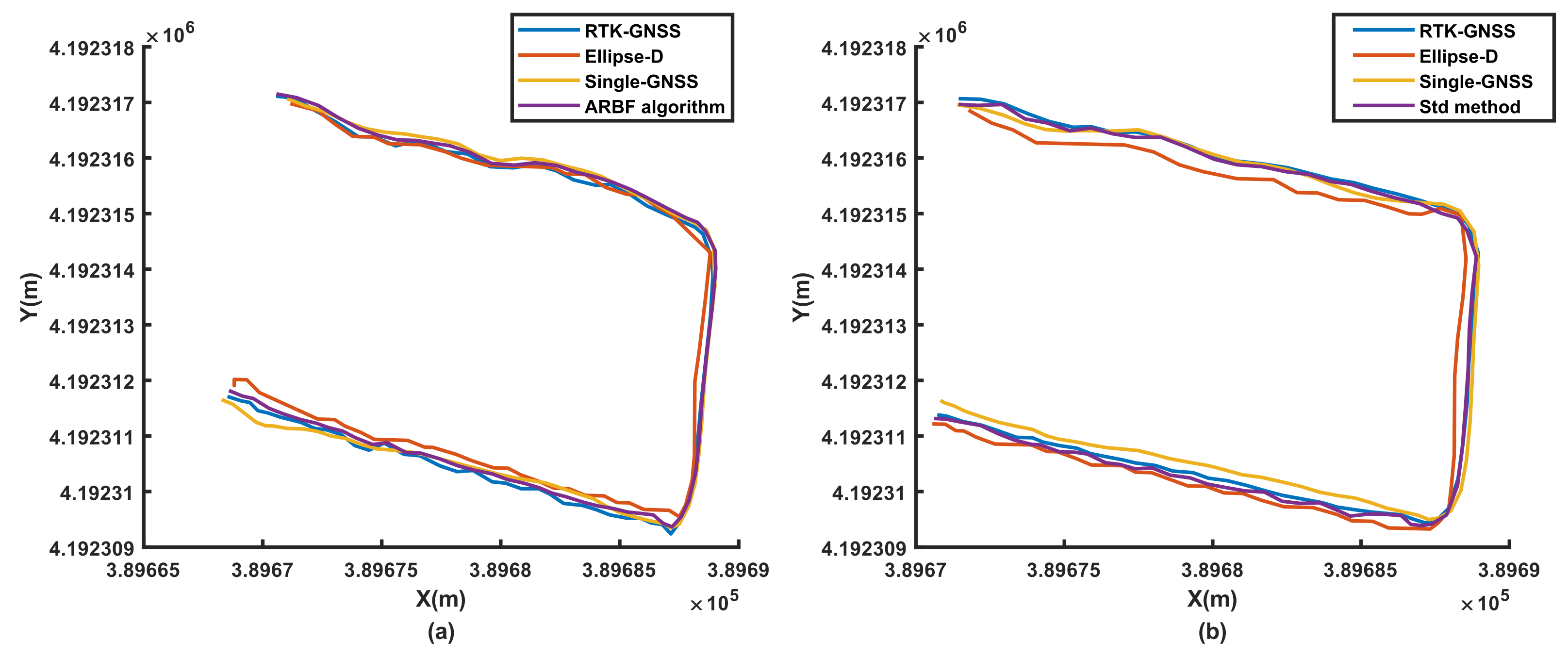1. Introduction
With the development of precision and smart agriculture, agricultural mobile robots (AMRs) have been widely applied in many fields [
1], such as planting, weeding, picking, and field transportation. The requirements of AMRs have increased with labor costs, and the variety of AMRs used have different application conditions. Jeon et al. [
2] developed a fully autonomous tillage tractor that could engage in path planning under given field conditions. Mahmud et al. [
3] designed a multi-objective AMR path planning algorithm with an optimized routing strategy using the genetic algorithm; this system reduced both the running time and service cost of the AMR. Aravind et al. [
4] noted that although AMRs are effective equipment for improving productivity without sacrificing the quality of agricultural products, the application effects differ based on the environment.
AMRs can be used for special functions by integrating various sensors to collect multidimensional information to construct sensor-motion feedback systems [
5]. Zhang et al. [
6] proposed a quadratic traversal algorithm to solve the weeding path planning problem using an AMR in a cornfield; the convolutional neural network (CNN) was applied to this system to quickly recognize weeds and generate the target edges. The weed contours were reflected in three-dimensional coordinates, and the targets were converted to motion control instructions for the AMR. Although the recognition accuracy reached 90%, this study did not consider the motion attitudes and directions of the AMR in dynamic and open external environments. With its limited anti-interference capability, an AMR would have trouble filtering environmental noise in real-time and may deviate from the expected path. In extreme cases, the degree of deviation of the AMR may increase gradually; thus, the AMRs may deviate completely from their expected trajectories. Therefore, it is necessary for the AMRs to correctly execute control instructions based on multisensor data collected from real-time motion states.
Nowadays, global navigation satellite systems (GNSSs), such as global positioning system (GPS), Beidou, Galileo, and Glonass, are widely used in military, agricultural, vehicle navigation, and other applications [
7]. The positioning accuracy of the traditional GPS is about 10 m, while this accuracy could reach 2 m with the help of a mobile communication station [
8]. With the development of various global satellite positioning systems, the positioning accuracy of the currently available GNSS is about 20–100 cm without assistance from other methods [
9]. However, GNSS is still not enough to cover the requirement in high accuracy and automatic positioning scenarios, such as agricultural seeder and rice transplanter requiring more accurate positioning. As a common assistant positioning method, real-time kinematic GNSS (RTK-GNSS) is a dynamic differential positioning scheme based on high-accuracy carrier-dependent observations [
10]. Thus, the positioning accuracy of the RTK-GNSS is about 1–3 cm. Emmi et al. [
11] studied a fused AMR based on an RGB camera, an inertial measurement unit (IMU), and the GNSS to achieve fast recognition of specific targets. However, both the GNSS and RTK-GNSS rely on open-air measurements to achieve high-accuracy positioning. Kanagasingham et al. [
12] developed a paddy field weeding robot with the help of a compass and GPS; the equipment was tested in a complex environment with a positioning accuracy of 100 mm. With the help of a vision system, the weeding robot could follow a predetermined path without damaging the plants. This study also showed that the resolution accuracy of the vision system may decrease with an increase in weed concentrations, thereby causing path deviations of the weeding robot. Considering that AMRs are often operated in complex environments covered by plants when the GPS signals are poor, the AMRs may deviate from their target paths, which negatively influences the tasks, in addition to the target detection camera and weeding machinery. Therefore, it is necessary to develop an AMR with accurate position prediction ability even when the satellite signals are affected.
The key to achieving high-accuracy position predictions for AMRs is multisensor data fusion. GPSs cannot provide high-accuracy positioning data when the satellite signals experience interference from buildings or trees. However, IMU and other motion sensors can work independently without being influenced by the external environment, whereas their accumulated errors may increase over time. Therefore, it is important to facilitate complementary data fusion between the GNSS and attitude sensors. Data fusion is widely used in multisensor situations [
13] to achieve high-accuracy position estimations. Yazdkhasti et al. [
14] proved that the Kalman filter (KF) is an effective multisource sensor data fusion algorithm for navigation sensors; thus, KF can be applied to multisensor fusion.
Zhang et al. [
15] proposed a pipeline mapping system based on the KF to fuse data from IMU and odometer sensors. In this study, the KF was used for multisensor data fusion to improve the horizontal and vertical positioning accuracies by 43% and 57%, respectively, for pipeline mapping and positioning test progress. The results showed that the KF played an important role in improving sensor measurement performance. Han et al. [
16] developed a low-cost GPS/IMU fusion system for position estimation. The IMU sensor multigroup GPSs were used to detect motion attitude data to build the multisensor fusion system based on KF. The position prediction accuracy of the system was 0.778 m for straight and 0.429 m for curved paths, which were 70.6% and 72.5% higher than those obtained with a single GPS, respectively. However, the GPS in this study supported only a single-band satellite signal with limited positioning accuracy. At the same time, the noise variance matrix of the KF algorithm was optimized using statistical analysis with fixed values in the experiments, whereas the noise of the KF may change dynamically in different environments. According to Ryu et al.’s [
17] research, the KF may not be able to effectively follow time-varying or unknown parameters owing to the influence of environmental noise, especially in nonlinear systems. Thus, noise optimization of the KF is important to improve its position estimation performance. The KF noise exists mainly in the state and measurement equations, e.g., state noise during uniform motion and measurement noise of the GPS and other sensors [
18], and is time-varying and nonlinear.
The commonly used methods to determine the KF noise are empirical estimations and statistical analysis. Yousuf et al. [
19] designed an IMU/GPS/odometer fusion system based on the KF. The noise value of the state equation was set as 0.1, and the noise of the measurement equation was set as the standard deviation of the sensors. Hu et al. [
20] proposed an adaptive KF algorithm based on covariance estimation of the state noise. The algorithm was based on the maximum likelihood (ML) of realizing dynamic updates, and the state noise was estimated with a large number of samples. Moreover, a fixed-length memory window was introduced to the algorithm to reduce its relative iteration time by 15.03%, while the position estimation accuracy improved by 33.5%. This research proved that it is crucial to optimize KF noise to improve position estimation accuracy.
In recent years, neural networks have been applied in many fields [
21]. With their nonlinear activation function, multilayer neural network, and back-propagation characteristics, machine-learning and deep-learning methods have important influences on feature extraction and nonlinear fitting. Pesce et al. [
22] constructed the radial basis function (RBF) to improve the anti-interference performance of the KF. The simulation results showed that the optimized KF had better filtering robustness, although the study lacked performance testing under complex environmental conditions. Zhao et al. [
23] proposed an adaptive KF indoor positioning algorithm based on CNN. The CNN extracted the state features and measurement noise of the KF, which was then applied to position estimation. With the optimized algorithm, the positioning accuracy improved by 22%, showing that the CNN approach had good effects on the noise parameter optimization of the KF algorithm. However, the study adopted only single-source data without multisensor fusion, because of which the positioning accuracies may reduce in complex environments.
Hence, the KF algorithm proposed in this work is based on multisensor fusion and neural networks for the position prediction of AMRs. The KF was used to fuse multisensor data, and the neural network was designed to optimize the noise parameter of the KF to improve position estimation accuracy. The main contributions of this work are as follows:
- (1)
An AMR test platform was built and integrated with an IMU/RTK-GNSS/rotary encoder to measure multidimensional motion data.
- (2)
The multisensor fusion algorithm was constructed using the KF method.
- (3)
A neural network was proposed based on the multisensor fusion algorithm to optimize the noise parameters of the KF equations.
- (4)
The performance of the proposed algorithm was evaluated via various experiments.
2. Materials and Methods
2.1. AMR Description
The framework of the AMR used in this study is shown in
Figure 1. The GOR400 (Gorilla Carts, Eden Prairie, MN, USA) was used as the AMR test platform. Its tire diameter is 25.4 cm, and the total length, width, and height are 86.4 cm, 45.7 cm, and 94 cm, respectively. The weight of the AMR is 17 kg. The assembled AMR with its sensors is shown in
Figure 2.
To accurately measure the motion attitude of the AMR, the MTI-30 (Xsens Co., Ltd., Enschede, The Netherlands) IMU was used in this work. The IMU contains a 3-axis accelerometer, 3-axis gyroscope, and 3-axis magnetometer with attitude fusion functionality. The output accuracies of the roll, pitch, and yaw are 0.2°, 0.5°, and 1°, respectively. The dual GNSS was constructed with simpleRTK2B (Ardusimple Co., Ltd., Lleida, Spain) and simpleRTK2B lite (Ardusimple Co., Ltd., Lleida, Spain). Based on the dual GNSS, the ESP32 XBee module, which contains network transport of RTCM via internet protocol (NTRIP) (Ardusimple Co., Ltd., Lleida, Spain) were integrated as the RTK-GNSS to provide high-accuracy positioning data. A 4G WiFi modem (A701, IEASUN Co., Ltd., Shenzhen, China) was used to provide access to the Internet to get corrected positioning data for RTK-GNSS. Further, the simpleRTK2B with a single antenna was used as a single-GNSS for comparison with the RTK-GNSS. The simpleRTK2B is based on the positioning chip (ZED-F9P, Ublox, Thalwil, Switzerland), which has the advantages of fast positioning and strong anti-interference ability. To improve the positioning performance of the simpleRTK2B, a calibrated survey GNSS antenna (Ardusimple Co., Ltd., Lleida, Spain) was used in the AMR, which supported GNSS as well as the Beidou, Glonass, and Galileo positioning systems. To collect real-time motion speeds of the AMR, dual rotary encoders E50S8-3000 (Autonics Co., Ltd., Seoul, Korea) were installed on the two rear wheels of the AMR. The encoders were established with rigid connections using ARM through the gears, which could output 3000 pulses per revolution (PPR); the maximum allowable PPR is 5000 revolutions per minute (rpm). Thus, the encoders not only meet the speed measurement requirements of the AMR but also provide good measurement accuracies. The above sensors were connected to the processing core, i.e., the Jetson Nano (NVidia Co., Ltd., Santa Clara, CA, USA) development kit. The Jetson Nano was used as the data collection and processing terminal and was connected to each sensor through USB serial ports to transmit data. The power supplies of all the AMR components were supported by the IP33120A-RED (E-power Co., Ltd., Ansan-si, Korea) battery.
The RTK-GNSS and single-GNSS data output baud rate was 9600 bps, transmitting data to the Jetson Nano via a USB-to-TTL line. The positioning data frame from RTK-GNSS and single-GNSS was
$GNRMC with time, calibration result, longitude, latitude, ground speed, etc., of which the data output frequency was 10 Hz. The output frequency and baud rate of the IMU were 50 Hz, and 115200 bps with data frames
$PRDID and
$PSONCMS. The
$PRDID provided the roll, pitch, and yaw data of the AMR, while the
$PSONCMS provided the 3-axis acceleration, 3-axis angular velocity, and 3-axis magnetometer details. The applied rotary encoders belonged to passive output equipment; thus, the encoder speed measurement module, i.e., STM32F103C8T6 development board (STMicroelectronics Group, Shenzhen, China) was used to handle the output pulse. The STM32F103C8T6 was set in the encoder working mode to count and convert the total pulses. The data output frequency of the STM32F103C8T6 was 2 Hz, and its baud rate was 115,200 bps. To reduce errors due to speed, the mean of the speed values of the two encoders was calculated as the speed of the AMR. The single-wheel speed is calculated as follows:
where
is the wheel speed, m
s
−1;
is the wheel radius, m;
is the period of data output which is 0.5 s; and
denotes the captured total pulse of the rotary encoder.
2.2. Establishment of the Multisensor Data Fusion Model
As a recursive optimal estimation algorithm, the KF mainly includes the prediction and update processes [
24], as shown in Equations (2) and (3). The
and
denote prior and posterior estimations, respectively;
and
denote measurement sensitivity matrix and state transition matrix, respectively;
and
represent the covariance and gain of the KF, which includes the state noise matrix
and measurement noise matrix
. The optimization of
Q and
R has a significant impact on the KF performance. The matrix determination method [
25] was used to calculate all the standard deviations (Std) of each dimension of the noise matrices independently.
Q and
R represent the degrees of confidence between the predicted value and measured data, i.e.,
Q and
R may change the weights of the predicted and measured values by impacting
. Therefore, reasonable
Q and
R matrices are important for improving the prediction performance of the KF.
Considering that the RTK-GNSS is influenced by buildings and trees, the RTK-GNSS, IMU, and rotary encoders should be fused [
26] to establish the state and measurement equations of the KF. The multisensor fusion algorithm combines position, attitude, and speed information. The AMR was thus simplified as a two-dimensional motion model [
27], as shown in
Figure 3.
According to the AMR motion model, the vector of the state equation is defined as
, where
represents the universal transverse Mercator (UTM) position coordinates of the AMR; and
denote the heading angle, speed, yaw-rate, and acceleration of the AMR, respectively, and the
is calculated by differential operation of
to obtain AMR’s motion state and trend. As the motion equation of AMR is nonlinear, the sensor data were fused with an extended Kalman Filter (EKF) according to Goncalves et al.’s research method [
28]. Each dimensional element of the state vector can be described with nonlinear formulas [
29] as follows:
where
and
denote the noise components of the yaw-rate and acceleration, respectively, and
is the time step of state updating. Thus, the matrix formula of the AMR is obtained as
where
is the noise of state equation, assuming that each state vector is statistically independent and the state equation noise follows the Gaussian distribution on (0,
Q). For the established AMR model, the measurement equation is as follows:
where
;
represent the measured position coordinates;
is the yaw angle obtained from the IMU sensor,
is the noise of the measurement equation, which is derived mainly from the drift noise of the sensors and stochastic noise of the external environment [
30] following the Gaussian distribution on (0,
R).
2.3. Optimization of Noise Matrix for Q and R
Research has shown that the noise matrices
Q and
R of the state and measurement equations have important effects on the performance of the EKF. With the development of deep-learning methods, applications in the field of data optimization are gradually increasing [
31]. As an important branch of deep learning, the unsupervised learning model has great significance for feature extraction and modeling of unlabeled data. Labeling and structuring data are complex tasks, which provide important bases for unsupervised learning to process unlabeled data. Ning et al. [
32] developed a neural network based on the RBF to improve the navigation accuracy of the EKF in GNSS and IMU integration systems in complex urban environments; with the help of the RBF neural network, the developed algorithm improved the position prediction accuracy of EKF when the GNSS signal was interrupted. Park et al. [
33] established a KF noise estimation algorithm based on denoising the autoencoder network; the core of this method involved obtaining a newly constructed sequence after feature extraction through the autoencoder. The autoencoder was designed to extract features of and denoise the KF. This study improved the accuracy of KF for effective battery voltage estimation.
The advantage of denoising with the autoencoder is based on its feature extraction and data reconstruction capabilities, while the RBF network [
34] can quickly model noise sequences using the less hidden layers and RBF function, i.e., Gaussian function. Considering that the goal of the EKF in this work is to optimize the
Q and
R matrices, the noise optimization algorithm based on the autoencoder and RBF (ARBF) neural network is proposed, as shown in
Figure 4. The autoencoder [
35] framework contains the autoencoder and autodecoder sections. The autoencoder section has a one-dimensional convolution of 1 × 3 for initial feature extraction from the input data sequence. To speed up data processing, eight convolution kernels are set in the first convolutional layer of the autoencoder section. The initial feature extraction sequences are processed by the max-pooling layer to reduce the network parameters and extract further feature information at the same time. Then, sixteen one-dimensional convolution kernels of 1 × 3 each are used to establish the feature information after the max-pooling layer, and the constructed autoencoder information is the output from the second max-pooling layer. The autodecoder section is designed symmetrically to reconstruct new data sequences. The LeakyRelu activation function [
36] is applied to the autoencoder neural network, which initializes the convolutional network with an minimal initial value to avoid zero gradients during network operation.
The new data sequence generated by the autoencoder process is represented as S1, and the difference between S1 and initial input sequence S0 is the noise sequence. The noise sequence is converted as the input of the RBF neural network with the Gaussian kernel function as follows:
where
represents the kernel function value of samples
, which are expressed as Gaussian kernel functions of
. To extract the noise value in the unsupervised mode, the clustering method is introduced to train the input noise sequence. The clustering method is a commonly used unsupervised learning method [
37]. In this work, the mutual reachable distance of each data point is calculated to obtain the target label as follows:
where
is the mutual reachable distance of the samples
a and
b;
and
are the core distances of samples
a and
b, respectively;
is the Euclidean distance between samples
a and
b; and
k is the smoothing factor. The mutual reachable distance enlarges the gap between the clusters, which provides a better clustering effect in theory. In this work, the cluster center value of the clustering method is the target noise, and the
Q and
R matrices of the EKF are constructed from the data noise sequence.
2.4. Experimental Method
The experiments in this work were divided into three parts, i.e., initialization, static, and dynamic experiments. Ellipse-D (SBG Systems S.A.S., France), which provides high-accuracy RTK-GNSS data, was used as the baseline. The experiments were implemented at Kangwon National University, and the experimental scenes are shown in
Figure 5. The red lines are the experimental paths. The initial test involved moving the AMR along the expected paths in
Figure 5a–c. During the progress, data were collected and calculated according to the state and measurement equations. The
Q and
R matrix parameters were generated from the proposed multisensor fusion and ARBF algorithm with the acquired data sequences. The static and dynamic experiments were carried out based on the initialized parameters. The static experiments involved placing the AMR at points P1–P4 for 40 min, as shown in
Figure 5d,e, to evaluate the static performance. The criteria for the static experiments are 50% circular error probability (CEP) and twice-the-distance root-mean-squared (2DRMS) values, whose formulas [
38] are as follows:
where
and
represent the Std of the UTM coordinates
and
.
The dynamic experiments involved two sections, i.e., three different ground environments and a single abnormal sensor, to evaluate the position prediction performance under different conditions. The three different ground environments include road, grass, and field, as shown in
Figure 6a–c, respectively. The single abnormal sensor condition contained data from RTK-GNSS with IMU and RTK-GNSS with encoder. In addition, to validate the performance of the proposed algorithm under the state that the RTK-GNSS data experienced interference, the metal plates were randomly applied to provide interference during the tests, as shown in
Figure 5f. The RMSE was used in this work to evaluate the dynamic performance, whose formula is as follows:
where
and
represent the predicted position coordinates, and
and
represent the baseline positioning data from the Ellipse-D equipment.
4. Discussion
In this study, the ARBF optimization algorithm shows good results for denoising. The denoised data sequences of the state and measurement equations of the EKF are analyzed using the mean and Std. The ARBF has little influence on the original data, i.e., the mean of each dimension does not change significantly, while the Std decreases, meaning that the dispersion degree of the original data also decreases. Denoising autoencoders are commonly used in data processing in many fields, such as image processing [
39]. In this study, the denoised sequence was obtained from the autoencoder neural network constructed using a one-dimensional CNN. The main process included data feature extraction by the autoencoder CNN and reconstruction by the symmetric autodecoder network. Theoretically, the generated sequence is the original denoised data. Although the original data changes, the special features are preserved. At the same time, the unsupervised learning mode of the RBF neural network was applied to model the noise sequence to calculate the target noise as the noise matrix of the multisensor fusion algorithm. Thus, the ARBF indirectly achieves the purpose of dynamically determining the noise matrix, which positively influences position prediction. Goncalves et al. [
28] developed a real-time classical stochastic model based on EKF and Gaussian distribution measurements error fusion to reduce the time to react so that the variance of position estimation was also reduced. Therefore, the ARBF algorithm in this paper could also be improved on the position estimation of robots in real-time. On the other hand, because the ARBF requires a significant amount of computing resources, it is important to deploy the model on a cloud server for remote interactions to improve real-time computing performance.
To evaluate the performance of the ARBF under the static state of the AMR, the 50% CEP and 2DRMS criteria were applied to determine the drift in position prediction. As classical accuracy indexes, these are widely used to determine navigation accuracies. Although the AMR was used under static conditions, the satellite signal was influenced by a variety of environmental factors, such as atmospheric conditions and buildings [
40], thus resulting in position drift. Additionally, sensors such as the IMU may contain slight drift, which can cause drift in the position prediction of the multisensor fusion algorithm. The 50% CEP and 2DRMS values were reduced by 25.9% and 24.4%, respectively, with the ARBF algorithm compared to the RTK-GNSS. Static experiments were implemented at points P1–P4, where the results had slight differences because the sites had different horizontal planes. Therefore, further studies with the same environmental parameters may be carried out to acquire better results.
The dynamic experiments were thus carried out in the three different ground environments. The RMSE results of the ARBF and Std methods show reduced maxima by 23.7% and 9.56%, respectively, compared to the RTK-GNSS data. Although both methods were able to accurately predict positions, the ARBF showed better performance, especially in the AMR turning process. Several studies have reported multisensor fusion experiments based on the GPS/IMU/encoder. For example, Feng et al. [
41] proposed a method to improve the robustness of the KF algorithm, and Liu et al. [
42] developed an adaptive KF algorithm based on multiple sensors to optimize the position prediction ability of the navigation system. The improvements in the accuracies of the systems were limited under the low-accuracy GPS. With the increasing demand for high-accuracy navigation, the RTK-GNSS is expected to have positive effects on position prediction. On the other hand, it is important to evaluate the position prediction performance when the RTK-GNSS contains interference or when the sensors work abnormally. The results of
Figure 12 indicate that the ARBF could still provide the predicted position data with poor RTK-GNSS signals. Although the RMSE increased, the prediction accuracy improved compared to that of the RTK-GNSS. The experiments involving lost encoder and IMU data show that the main effects of the encoder are to provide the velocity of the AMR for displacement integration to enhance the robustness of position prediction. When the IMU data are lost, the position prediction of the AMR shows serious deviations, indicating that the constructed system relies on the IMU sensor to obtain the motion attitude to achieve high-accuracy position prediction. This indirectly explains the importance of multisensor fusion for high-accuracy position prediction. However, the system presented herein for the AMR does not provide predictions of the heading angle, which is of great significance for navigation [
43]. Thus, a possible improvement direction is to build a multisensor fusion optimization algorithm with a heading angle prediction function. Because the encoders are used to measure real-time velocities, the overall data output frequency can be increased through further study to satisfy the requirements of high-speed navigation and positioning. With the improvement in edge computing capabilities and increasing application of vision-based navigation, it is essential to combine the proposed system with vision navigation. In addition, because the AMR or vehicles may experience interference in long tunnels, with interruption of the RTK-GNSS or GNSS signals for different durations, it is important to study multisensor fusion algorithms [
44] in such situations.


